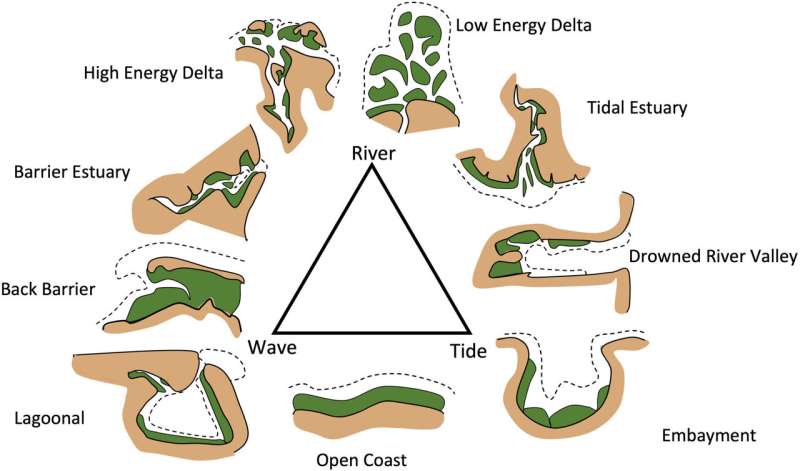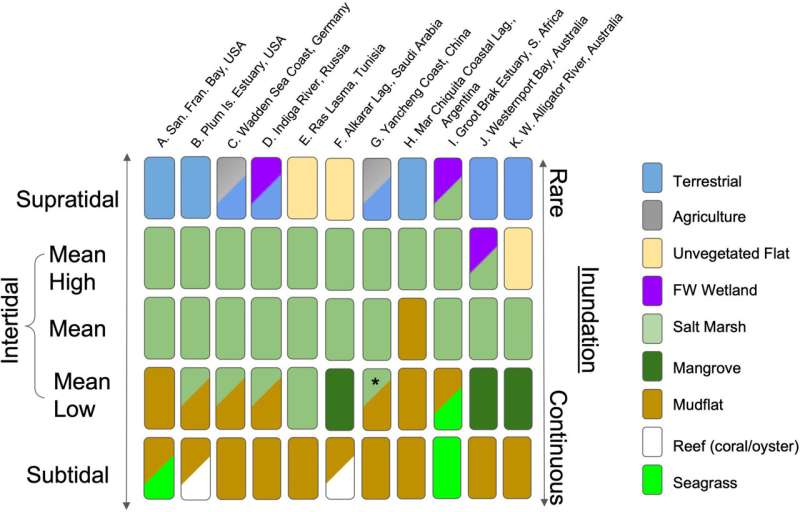
Coastal settings continuum, where salt marshes are present based on dominant forcing. Dotted line indicates intertidal extent, green areas indicate salt marsh, and brown areas are adjacent upland ecosystem (adapted from Rogers et al. 2017 and Dalrymple et al. 1992). Credit: Limnology and Oceanography Letters (2023). DOI: 10.1002/lol2.10346
Dr. Scott F. Jones, University of North Florida assistant professor of biology, co-led recently published research from an international team of scientists that offers a united, conceptual framework for approaching salt marsh studies. The project aims to encourage cross-disciplinary and global collaborations, ultimately dramatically improving understanding of salt marsh ecosystem functions by appropriately framing the science.
Salt marshes link land and sea throughout the world and are essential for protecting coastal communities from the devastating impacts of storm surge, reducing nitrogen and storing carbon to help slow the effects of climate change and serving as critical habitat for many varieties of fish and plant life.
These transitional ecosystems are varied and unique but are often studied as if all salt marshes were identical. This project united global scientists to draft a conceptual framework that allows comparison of salt marshes in a more rigorous and equitable way.
Jones’ fellow co-leads on the project, biologists Drs. Erik S. Yando, Old Dominion University, and W. Ryan James, Florida International University, conceptualized the paper over the course of several years. The team synthesized a wealth of experience in collaboration with international co-authors from Argentina, United Kingdom, South Africa, China, Saudi Arabia, Australia and Russia.

Examples of salt marsh tidal position and adjacent ecosystem types. Inundation level is presented along a vertical gradient from rare to continuous. *Invasive species are now dominant. Credit: Limnology and Oceanography Letters (2023). DOI: 10.1002/lol2.10346
Their work reviews ecosystem-relevant drivers from global to local spatial scales, integrates these multi-scale settings into a framework and provides guidance on applying the framework using specific variables on 11 global examples of salt marshes. The conceptual framework allows for appropriate comparison of study sites by accounting for the uniqueness of each individual salt marsh.
The research is published in the journal Limnology and Oceanography Letters.
More information:
Erik S. Yando et al, An integrative salt marsh conceptual framework for global comparisons, Limnology and Oceanography Letters (2023). DOI: 10.1002/lol2.10346
Citation:
Collaborative salt marsh research championed by global scientists (2023, August 8)
retrieved 8 August 2023
from https://phys.org/news/2023-08-collaborative-salt-marsh-championed-global.html
This document is subject to copyright. Apart from any fair dealing for the purpose of private study or research, no
part may be reproduced without the written permission. The content is provided for information purposes only.
>>> Read full article>>>
Copyright for syndicated content belongs to the linked Source : Phys.org – https://phys.org/news/2023-08-collaborative-salt-marsh-championed-global.html































